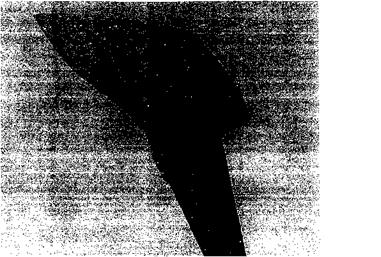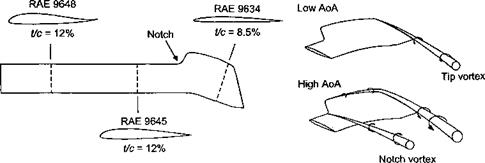Case Study: The BERP Rotor
The British Experimental Rotor Program (BERP) blade has been alluded to previously and is worthy of special consideration because its design encompasses some of
|
Figure 6.21 Photograph of the BERP blade as used on the Westland Lynx. (Courtesy of Westland-Agusta.) |
the issues discussed in the previous section. The BERP rotor was designed specifically to meet the conflicting aerodynamic requirements of the advancing and retreating blade conditions, either of which can limit the C^/Cq of the blades and the performance of the rotor in high-speed forward flight. The technical details of the BERP research program are described by Perry (1987), Perry et al. (1998), and Wilby (1998). This research paid off in 1986 when a Westland Lynx attained the world absolute speed record for a conventional helicopter.
As shown in Fig. 6.21, the BERP rotor blade is distinctive because of its unique tip shape. However, the aerodynamic improvements shown with the BERP rotor are the result of several innovations in both airfoil design and tip shape design. The BERP blade uses a number of high performance airfoils based on the RAE family (see Fig. 6.22). The main lifting airfoil is the RAE 9645, which is located on the blade from 65 to 85% radius. This airfoil has a maximum lift coefficient of about 1.55, which is high compared to even second- generation helicopter airfoil sections – see Dadone (1976) and Wilby (1998). However, this high lift coefficient is obtained at the expense of higher pitching moments. These pitching
|
Figure 6.22 Distribution of airfoil sections on the BERP blade and high angle of attack performance. Adapted from Perry (1987). |
moments are offset by the RAE 9648 airfoil, which is reflexed and located inboard of 65% radius where the demands of high maximum lift are not so important. The tip region uses the RAE 9634 airfoil, which has a relatively low thickness-to-chord ratio to give a high drag divergence Mach number. The RAE 9634 airfoil is also cambered in such a way as to give a weak shock wave and low pitching moments.
A distinctive feature of the BERP blade is the use of high sweepback over the tip region, which as mentioned previously, is an effective means of reducing compressibility effects and delaying their effects on the rotor to a higher advance ratio. On the BERP blade a progressively increasing sweepback angle is used over the outboard 16% of blade radius. Because the Mach number varies linearly along the blade, the amount of sweep that is necessary can be minimized by keeping the Mach number normal to the leading edge approximately constant – see Section 6.4.6. What is different for the BERP blade is that the area distribution in the tip region is configured to ensure that the center of lift is located close to the elastic axis of the blade. This is done primarily by offsetting the location of the local 1/4-chord axis forward starting at 86% radius. This offset also produces a discontinuity in the leading edge of the blade, which is referred to as a “notch.”
It must be recognized that while a swept tip geometry will generally always reduce profile power and delay the onset of increased power requirements to higher advance ratios, it will not necessarily improve the performance of the blade at high angles of attack on the retreating side of the disk. In fact, results have been previously shown in Fig. 6.16 that a swept tip blade may have inferior forward flight characteristics compared to a standard (unswept) blade tip. The BERP blade is specifically designed to perform as a swept tip at high Mach numbers and low angles of attack, but it is also designed to operate at very high angles of attack without stalling. This latter attribute is obtained, in part, through the generation of stable vortex flows that enhance lift and delay the onset of gross flow separation over the tip region to extremely high angles of attack (see Fig. 6.22). This mechanism is promoted by giving the airfoils in this region a small leading edge nose radius. As the AoA of the blade is increased, this vortex begins to develop from a point further forward along the leading edge into the less highly swept region. At a sufficiently high angle of attack, the vortex will initiate close to the forward most part of the leading edge near the notch region. Experimental evidence by Duque & Brocklehurst (1990) have shown that a second notch vortex is also formed, which is trailed streamwise across the blade. This vortex acts like an aerodynamic fence and retards the flow separation region from encroaching into the tip region. Numerical calculations by Duque (1992) have shown that in high-speed flight this notch also helps to further reduce the strength of shock waves on the tip, acting as a form of “tip relief’ – see Section 5.4.3. Further increases in AoA make little change to the flow structure until a very high AoA is reached (in the vicinity of 22°) when the flow will finally break down and separate. For a conventional tip planform, flow breakdown would be expected to occur at about 12° local angle of attack.
The performance of the BERP rotor is confirmed by the results shown in Fig. 6.23, which is based on actual flight tests using the Lynx helicopter – see Perry et al. (1998). The results are shown in terms of blade loading coefficient versus advance ratio. Clearly the BERP rotor demonstrates a significant increase in the operational flight envelope. Further results are shown by Perry et al. (1998), who compared the BERP rotor with other rotor blades in terms of hovering performance and the maximum thrust capability in forward flight. Despite some controversy about comparing rotor performance in forward flight on the basis of weighted solidities [see Amer (1989) and Perry (1989)] the performance gains of the BERP rotor are convincing and clearly demonstrate the benefits of a careful synthesis of both improved airfoil design and blade planform shape in the design of better helicopter rotors suitable
|
Figure 6.23 Flight envelope of the Lynx with standard rectangular blades and BERP blades. Data source: Perry et al. (1998). |
for high-speed forward flight. The latest derivatives of the BERP blade have used some anhedral over the tip region, which provides some additional gains in performance. The success of the BERP program has seen the blades retrofitted to the fleet of military’ Lynx helicopters, and the design is also used on the EH-101 helicopter.














